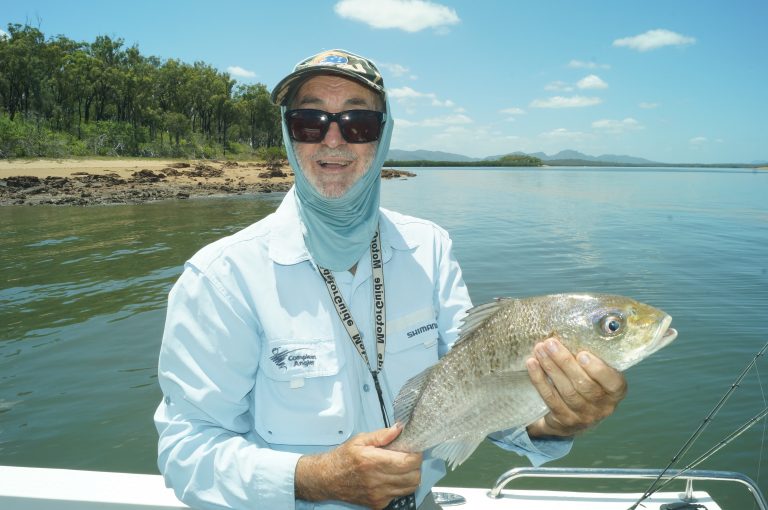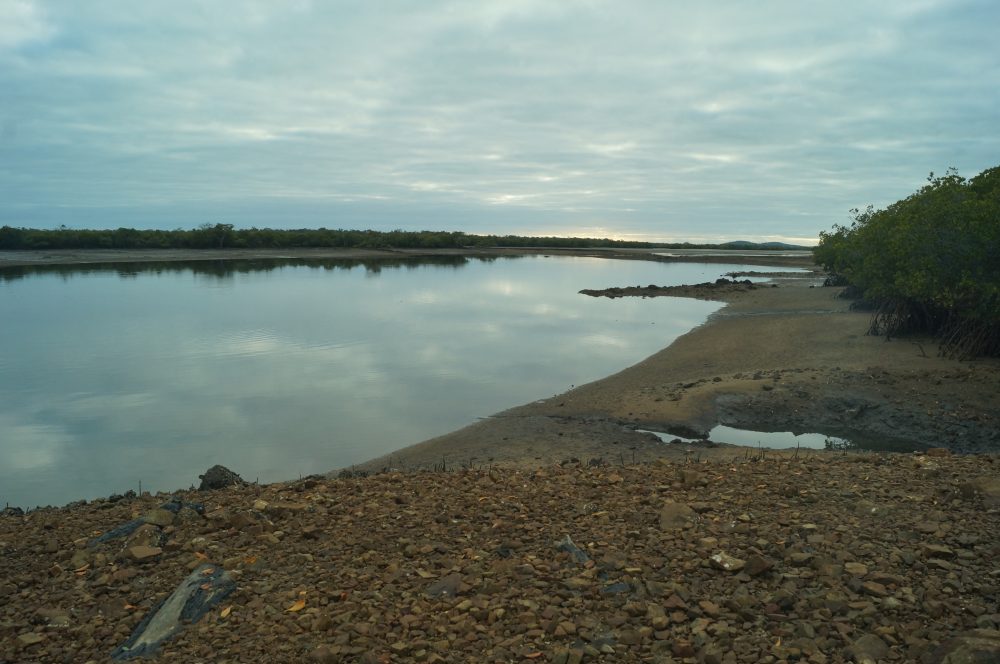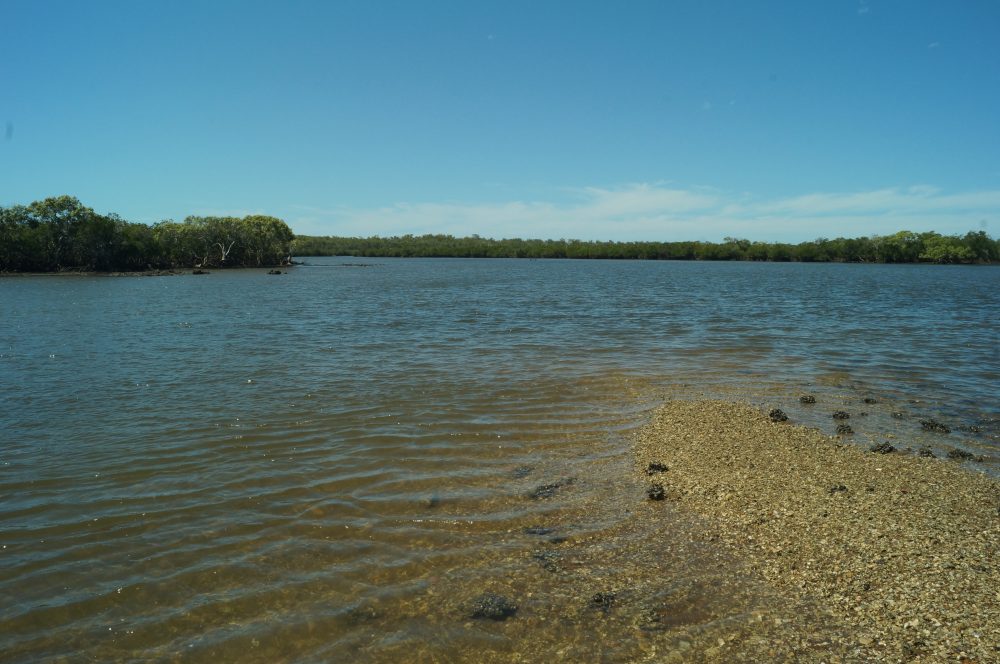Hunting Grunter with Hard-bodies – By Dave Magner
Dave Magner takes his bream gear chasing Barred Javelin (aka grunter) and finds out what an under-rated shallow-water sportfish they really are.
While I’ve caught quite a few grunter over the years, they have never been a species that I specifically targeted. Up until recently, most of the grunter that I had caught were little more than by-catch whilst seeking out other species. I knew they ate lures, but I would have assumed that soft plastics would always out fish hard-bodied lures when chasing them.
A couple of recent trips have really turned that thinking around. I’ve actually been enjoying some surprisingly consistent success targeting grunter on small hard-bodied lures. It turned out that all I needed to do was lock onto them as a target species. Then, once I started putting the right lures in the right places, it opened up some of the most enjoyable light tackle sportfishing I have ever experienced.
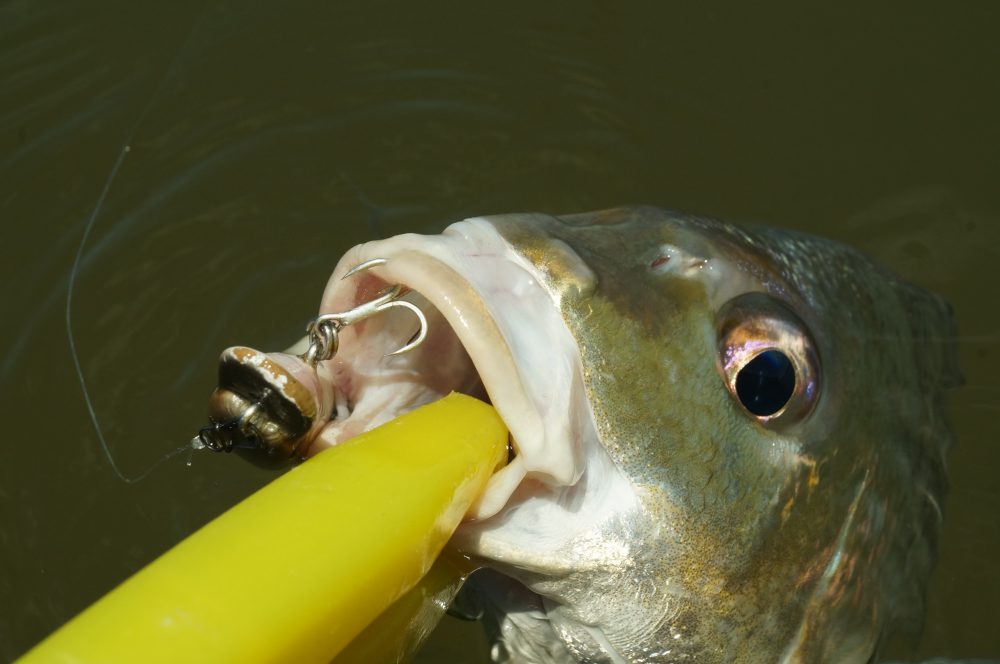
That underslung mouth tells you a lot about the feeding habits of grunter.
Lucky Break
I wish I could say that my success has come from hard work and clever thinking on my part, but that would be a total fabrication. I actually stumbled onto the whole grunter on hard-bodies thing completely by accident.
The first time I cracked the code, I was meant to be chasing jacks and salmon with my good mate Steve up the back of Seven Mile Creek. Sadly, we hadn’t had much luck with either of our intended target species, so in frustration I put down my heavier outfit and picked up my bream rod, which just happened to be rigged with one of Ray Broughton’s little 60mm Shimmy lures.

RTB Shimmy lures in profile. This pair of veterans have numerous grunter captures to their credit.
Anyway, I made a few speculative casts across a shallow mudflat and as the tiny lure was bumping its way across the bottom, it suddenly came to a complete stop. The next thing I knew, the rod was loaded up into a serious curve and braid was screaming off the little spin reel at a ridiculous rate. The high pitched tune my drag was singing immediately let me know this was no bream or flathead. Clearly, I’d hooked something completely unexpected.
Luckily for me, the fish made its first run parallel with the mangroves, rather than straight back into them as there was no way I could have stopped it from burying me in the timber on the ultra-light flick stick and six pound braid. I pushed my outfit as hard as I dared and somehow managed to turn the fish’s head for a second or two, before it took off on another sustained run that scorched back across the mudflat.
Whatever this thing was it had a turbo up its tail!
At this point, the long, powerful runs started to make me wonder if I had foul hooked a big stingray, but then I caught a flash of silver in the shallow water. Realizing it was a fish rather than a ray made me more determined than ever to land it, so that I could at least find out what I was attached to. My mind started running through the possibilities. Was it a king salmon, a barra or a giant herring? Then I caught a better glimpse of my opponent and those dark vertical bars running down its deep silver flanks instantly gave its identity away. It was a grunter, and a damn good one at that.
After a couple more defiant runs, I finally managed to work the fish to the boat and Steve scooped it up in the net for me. It was indeed a grunter or barred javelin and at 66cm on the brag mat, a personal best for me by a very healthy margin. I will admit feeling so excited and relieved at landing such a tough opponent that I even let out a yell of delight when that fish was finally in the boat.

The author with a serious handful of sportfish. Big grunter are under-rated for their fighting ability.
That fish really opened my eyes to what a great sportsfish these things are. While there were no aerial antics, it had speed and power that would have put a lot of other more glamourous species to shame. It was a top shelf light tackle opponent and I knew right there and then that I had to have a more serious look at these things and work out how to catch them consistently.
Gearing Up for Grunter
As I’ve already pointed out, I’m still only just getting my head around the whole grunter on hard-bodies thing but I’ve had enough initial success to make me think I’m on the right track. So, I’m happy enough to share a few little hints here with anyone who’s keen to give it a crack.
Firstly, if you are chasing grunter in the shallows, which is where they are most likely to eat a hard-body, lure size seems to be very important. While they will happily eat a baitfish if the opportunity presents itself, they generally seem to be more of a forager. Sure, when they are in the mood they will attack just about any lure, but to consistently fool them small lures seem much more acceptable. Think prawn size or smaller.
As I described earlier, tiny, bream sized lures have quickly become my ‘go to’ option for grunter. While there are any number of great little lures on the market that could do the job, personally I don’t think you can beat the two smallest sized RTB Shimmys. At 50 and 60 mm respectively, these shallow running timber beauties are an ideal ‘bite sized’ offering. For such a small lure, they have enough built-in buoyancy to be retro fitted with grunter capable hooks without it sandbagging their action.
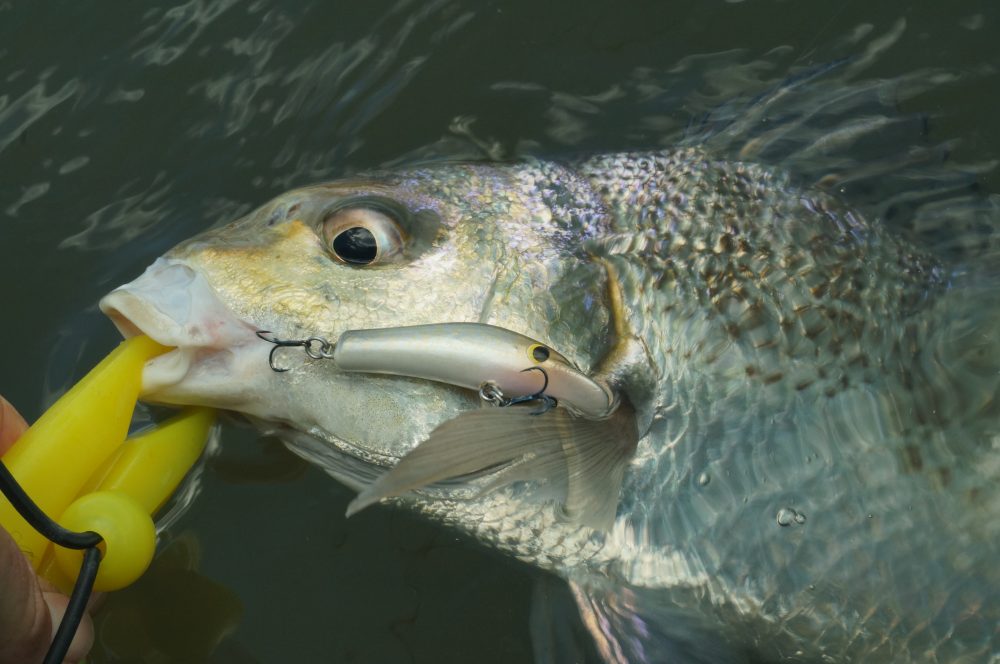
This grunter is typical of the fish you find up on the flats. At close to the legal size limit of 40 cm, it is a great little light tackle sportfish.
While colour doesn’t seem to be all that important, the subtle, mottled paint schemes that Ray utilizes look perfectly at home on the broken shell/mudflat environment that grunter seem to prefer. Shimmys just look so natural that the fish hit them confidently and the takes are always solid. The final plus is that they are made here in Australia, rather than overseas, so I’m able to support our local lure manufacturer into the bargain.
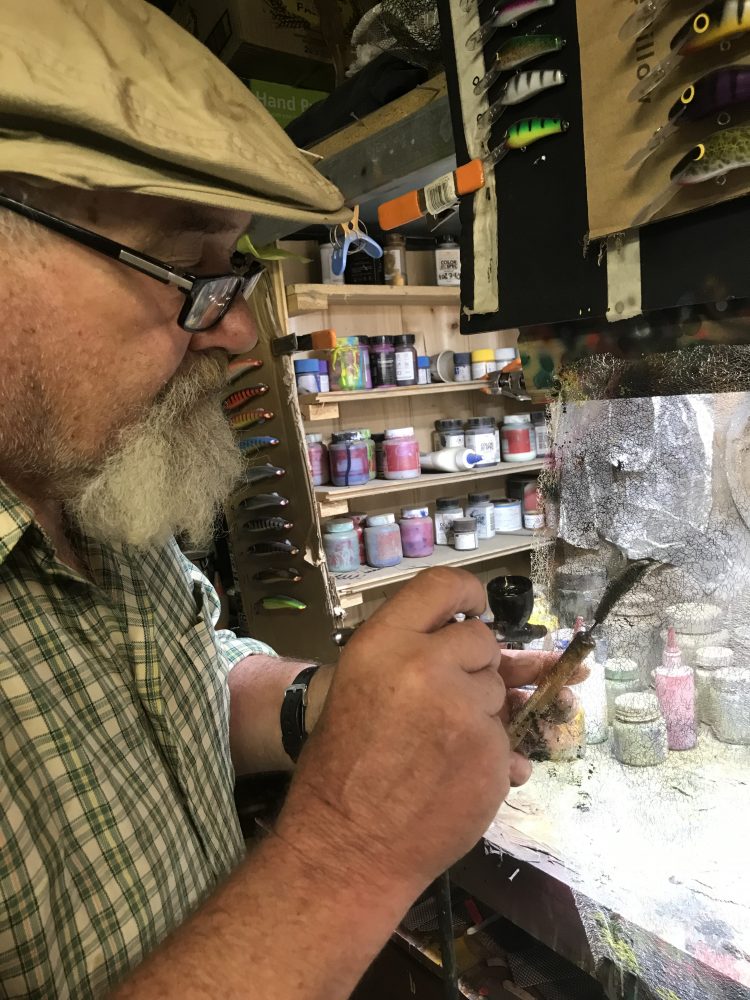
Ray Broughton painting a 60mm Shimmey Fishing Lure
Of course, to cast such small lures you need an appropriate rod and reel. Your typical seven foot bream combo should do the trick. I’ve just lashed out on a new one – three kilo rated Abu Volatile spin rod and it’s an absolute cracker. I’ve paired it to a 3000 sized Quantum Smoke Inshore spin reel, which has been spooled with 6 pound braid. It’s proven to be a very effective and user friendly outfit to fish with so far.
For leader I normally run 12 pound fluorocarbon. It probably sounds a bit heavy in comparison to the rest of the outfit, but you need the extra protection to cope with the larger grunter, which have plenty of leader cutting sharp bits on them. A heavier leader also comes in handy when a big old flathead swallows your little minnow all the way down the back of its throat, which is bound to happen occasionally if you are fishing the right sort of country.
Grunter Grounds
I know it probably sounds risky to use such a light outfit in central Queensland where there are so many high profile sportfish on offer. Fortunately, the feeding habits of grunter are quite a bit different to most of the other more sought after species. That means once you specifically start to target them, you won’t have to worry too much about encounters with ambush predators like jacks and barra.
To target grunter, the first change I had to make was to move away from casting at hard structure like rock bars, mangrove roots and fallen timber. Instead, I started searching out relatively open water over shallow mudflats, particularly those flats with a good scattering of broken rock and oyster shells. If you check out the photos hereabouts, they should give you a good idea of the sort of country I’ve been focusing on.
So far, most of my grunter on hard-bodies have come from less than a metre of water and often less than half a metre. To fish such shallow water, I was using my kayak, but since buying my first tiny boat, I’ve been spending an awful lot of time in it, as it is near ideal for the job.
Whatever platform you prefer, it just needs to be able to navigate quietly and safely in extremely skinny water. Getting right up there in the shallows has been a real eye opener. I’ve been seeing large schools of grunter ghosting quietly along the outside edge of the mangroves. Until I started looking for them, I honestly had no idea how numerous these things are. While most are only in the 30-40 centimetre range, they appear to be one of the most common fish on the flats.
Getting on the water at the right stage of the tide is another key element to success. I like to fish a few hours either side of high tide. This gives me at least a couple of hours to intercept the fish as they work their way into, or drop back out of the mangroves.
Over the top of the tide, you will usually find things a bit quiet as the fish will move right up in amongst the flooded forest of mangrove roots. Conversely, once the water has completely dropped out of the trees, I find the fish quickly retreat to deeper holes to sit out the low. If you can find deep water nearby, you can still catch grunter, it’s just that you need to use different methods like soft plastics or vibes.
Of course, if you can time your trip so that the right stage of the tide coincides with a nice still early morning, then so much the better. With calm, sunny conditions you can often sight cast to the fish, which is the stuff of fishing dreams.
The Three Keys
From what I have learned so far, the keys to consistently catching grunter on hard-bodies can be summed up in three main points. First, use small, bream sized floating minnows on correspondingly light tackle. Secondly, fish shallow rocky/mud flats near substantial stands of mangroves. Lastly, fish from half tide in, to half tide out. If you get those three things right, I’m sure you’ll have as much fun as I’ve been having.
Why Hard-bodies
While soft plastics can be deadly on grunter, the reason I prefer hard-bodied lures is because floating lures are so much easier to fish with in the snag studded shallows. Unfortunately, jigs, blades or any type of sinking lure that makes regular contact with the bottom during the retrieve have a high chance of getting snagged on rocky bottom. A floating hard-body on the other hand, can be retrieved so that it swims just over the top of the structure, with the bib acting as a deflector and keeping the hooks clear of the snags most of the time. Even if your hard-body does get stuck, you can often just give the line a bit of slack and the lure will float free by itself, allowing you to spend more time fishing and less time re-rigging.
Size and Possession Limits
Barred Javelin Fish (aka grunter) are a tropical or semi-tropical species which can be found around the top half of the continent from Shark Bay, Western Australia to northern New South Wales.
In Queensland, grunter have a minimum size of 40cm and a possession limit of 10 but please be sure to check the Queensland Government Recreational Fishing Rules page (https://www.qld.gov.au/recreation/activities/boating-fishing/rec-fishing/rules/limits-tidal#javelin) or the rules in your state for the most up-to-date regulations for your local area.


